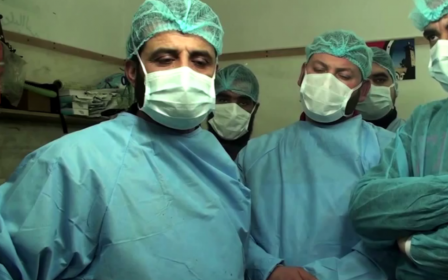New Aleppo offensive: Is Assad afraid of French and Turkish retribution?

A major flare up in fighting has begun in the war-torn city of Aleppo and the strategic rebel-held towns to its north. This was the result of a “surprise” offensive by regime forces, backed by local as well as foreign paramilitary groups like Hezbollah.
It does not, as many believe, aim to completely besiege the rebel-held east part of the city, but rather to weaken rebels there by cutting off their main supply route to the northern countryside and Turkish border. If the aim were a siege, the push would have been further to the south targeting the Castelo road through the Mallah Farms, although that may yet happen pending any new developments - or lack of - on the political scene.
The second objective is to reach the besieged Shia loyalist towns of Nibol and Zahra. Those two enclave towns act as vital regime fortresses in an otherwise completely hostile rural battlefield, and have their own large contingent of local fighters defending them from repeated assaults led by mainly Islamist rebels as well as the al-Qaeda affiliate Jabat al-Nusra. Reaching those towns is a high priority for the regime and would provide a much needed moral as well as a strategic victory to boost its pressured forces and loyalists.
A full siege of Aleppo is problematic for the regime, as it’s a very thorny and sensitive issue politically, with both France and Turkey signalling they may get directly involved to prevent it. In fact, pro-regime media charges that Turkey is already directly involved in this latest battle, bolstering rebel defences with weapons, logistics and even officers on the ground. This wouldn’t be the first time Turkey was involved in a military operation in north Syria, as recent wiretaps showcased in court files in the trial of Islamic State suspects in Turkey reveal close coordination and even artillery support for last year’s rebel assault on the Armenian town of Kassab, which included among others fighters from al-Nusra attacking through Turkish territory.
This is why an all-out regime assault on Aleppo has been repeatedly put off, the latest occasion being in December of last year when an offensive seemed imminent but was postponed due to Russian pressure to allow the diplomacy of UN Syria envoy Staffan Domingo de De Mistura’s freeze initiative for Aleppo, as well as its own attempts at holding talks in Moscow between the Syrian government and representatives of various opposition groups.
To observers watching the Aleppo scene closely, this latest offensive wasn’t much of a surprise, however, as large regime reinforcements were reported to have arrived in Aleppo last week. The aim seems to be a lightning-quick operation to change battlefield conditions ahead of any potential truces or ceasefires, thus cementing those strategic gains.
This would go some ways in explaining the odd nature of the assault, which seems almost like a rushed job, relying as it did on large numbers of infantry with little armour and no artillery or air cover due to bad weather. This is an unusual tactic, as previously most regime advances have been slow and calculated and heavily preceded by bombardment and covered by armour and airstrikes. This did result in the quick fall and capture of several strategic towns, but at the cost of a large number of casualties and POWs as the defending rebels regrouped and launched a counter offensive, retaking an important front line town, Rityan.
Initially, rebel ranks and defences were caught unprepared, as diversionary attacks were launched by the regime on several fronts in and around the city of Aleppo which caused a great deal of confusion and disarray. However, they managed to call up significant reinforcements from across Aleppo province, as well as nearby Idlib, including jihadist groups like al-Nusra and Ansar el-Deen.
It is important to note that Aleppo’s north countryside - the scene of the current battle - is where a majority of its rebels hail from, and hence their strategic heartland. Those rebel groups are by no means a coherent or uniform whole, and are instead centred around the towns they come from, although they sometimes cooperate under umbrella organisations or unified command rooms like the Levant Front.
The largest factions are Islamic, meaning they advocate for a theological Sharia state rather than a secular democracy. The so-called “moderate” groups like Hazm, who have received direct US military aid, are relatively small and have recently been routed by jihadist groups like al-Nusra from most of their bases and strongholds.
Other smaller “moderate” rebel formations which operate in and around Aleppo are too noxious and openly criminal for anyone to work with. One of those is the notorious Forqa 16 led by Khaled Hayani which operates in Bani Zied in Aleppo city, and has been accused by the opposition Syrian Observatory for Human Rights (SOHR) of being responsible for over 300 civilian deaths through indiscriminate shelling of neighbourhoods in regime areas.
The bulk of regime forces in Aleppo are composed of a mixture of regular army units and paramilitary groups drawn locally from volunteers like Baath party loyalists (the Baath Brigades), as well as various towns in Aleppo’s south (National Defence Forces plus Ligan). There is even a predominantly Palestinian militia, Liwa’ al Quds, which is drawn from the nearby Handarat refugee camp, currently under rebel control.
In the latest offensive those major formations were joined by additional foreign forces, most notably the Lebanese Shia militant group Hezbollah, as well as some Shia volunteers from Iraq and parts of Central Asia. The Syrian opposition also claims there is a sizable Iranian contingent, including Iran's Revolutionary Guard Corps (IRGC) officers which oversee important combat operations.
The current situation remains fluid and fierce fighting is still ongoing, with each side claiming victory and new advances, backed by the usual propaganda from local and regional media operations respectively backing them that includes footage of dead combatants as well as POW’s.
It’s never easy to know for sure what is going on in Aleppo’s fronts, and this latest one is no exception. The fog of war is exceptionally thick in this blighted city, and a clear picture in this important battle will only emerge once the dust has settled. Only then can a proper assessment be made of where this leaves any diplomatic initiatives.
As it stands now, both the main opposition umbrella group in Istanbul, the Syrian National Coalition (SNC), as well as the rebel leadership linked to it - the Revolutionary Command Council (RCC) - have come out and rejected the initiative, accusing De Mistura of being biased after he stated that Assad had to be part of any solution. It goes without saying that jihadist groups, which hold the most power on the ground, reject any diplomacy outright, and actively work to scuttle any such deals as has been the case in areas around Damascus.
The plan was always going to be a difficult sell in any case, and although the Syrian president had welcomed it - even offering a six-week cessation of artillery and aerial bombing in Aleppo - there are lingering suspicions by both sides that any freeze would ultimately benefit its opponents. The rebels believed it would free up the regime’s military assets allowing them to be deployed elsewhere, especially the newly active and crucial southern front in Deraa, whereas the regime believed this would de facto cement rebel and opposition rule over much of Aleppo city, and appear like they had ceded that territory for good.
The people of this shattered city don’t hold out much hope of any imminent respite to their suffering, regardless of the result of this latest round of fighting or the current diplomatic push. They’ve been stuck for so long in a bloody and deadly stalemate that they’ve almost forgotten what life without constant fear and war is like.
The rebel held east part is routinely bombed by regime aircraft and is largely devastated and emptied of its inhabitants, with control in most areas devolving to hardline Islamist or jihadist militias amid a complete lack of any vital civil infrastructure. The regime west part continues to limp along, toiling under the crippling strain of severe and chronic shortages of basic services, power, water, fuel and other necessities while suffering daily shelling by rebels, resulting in a large loss of life and casualties. The hope that all this may end one day soon seems to most people here to be nothing but a cynical joke.
- Edward Dark is MEE's Aleppo-based columnist and writes under a pseudonym.
The views expressed in this article belong to the author and do not necessarily reflect the editorial policy of Middle East Eye.
Photo: Men carry the body of a pro-regime fighter on 18 February at a morgue in the rebel held area of the northern Syrian city of Aleppo (AFP)
New MEE newsletter: Jerusalem Dispatch
Sign up to get the latest insights and analysis on Israel-Palestine, alongside Turkey Unpacked and other MEE newsletters
Middle East Eye delivers independent and unrivalled coverage and analysis of the Middle East, North Africa and beyond. To learn more about republishing this content and the associated fees, please fill out this form. More about MEE can be found here.





